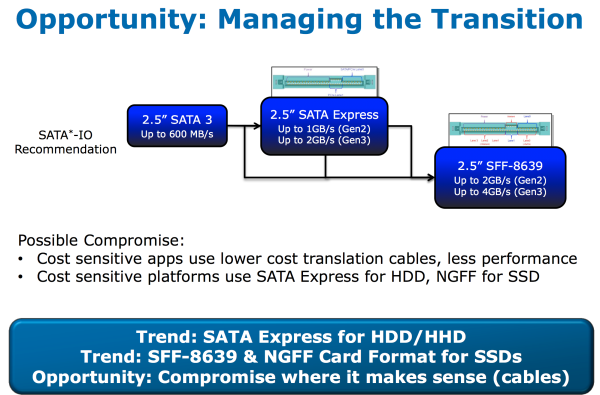Breaking the SATA Barrier: SATA Express and SFF-8639 Connectors
by Anand Lal Shimpi on September 13, 2012 2:41 PM EST- Posted in
- IT Computing
- SSDs
- Intel
- SATA Express
- Trade Shows
- IDF 2012
Pretty much all high-end client SSDs have no issues saturating the current 6Gbps SATA interface. We've talked about a move to PCIe based SSDs but these are the connectors that will do it.
On the right you have SATA Express, which will deliver up to 1GB/s on PCIe 2.0 and up to 2GB/s over PCIe 3.0. On the left there's the eventual landing place: the SFF-8639 connector, good for PCIe x4 with speeds of up to 4GB/s (PCIe 3.0).
Most client machines will likely use the new NGFF card form factor, but for huge capacities and performance (e.g. servers in the enterprise) we'll see a move from SATA to SATA Express to the SFF-8639 connector over the next few years.











20 Comments
View All Comments
repoman27 - Thursday, September 13, 2012 - link
Because this isn't an external interface, it's for internal drives using classic SAS/SATA form factors.While SAS 12Gb/s is forthcoming for enterprise applications, SATA-IO has determined that moving SATA to 12Gb/s at this juncture does not align very well with the organization's stated goals. Instead they are focusing on SATA Express so that SSDs using conventional SATA HDD form factors with have an interface that does not constrain performance, while still maintaining compatibility with previous generation SATA motherboards.
DuckieHo - Thursday, September 13, 2012 - link
Thunderbolt increases latency and cost. Plus I doubt it meets enterprise standards.repoman27 - Friday, September 14, 2012 - link
10GbE meets enterprise standards, but you don't see people trying to use it to connect hard drives to motherboards or backplanes inside servers.SFF-8639 and SATA Express are integrated interfaces for HDDs, HHDs and SSDs, Thunderbolt is an external interface for PCIe and DisplayPort devices.
iwod - Friday, September 14, 2012 - link
I bet we could Max out 1GB/s upon SATA Express arrival. I hope we are going to use PCI-E 3.0 spec when it is release. Which seems likely looking at the time frame.We would properly take 1 - 2 years to achieve 2GB/s, and then i guess pushing further is going to get a lot harder. i.e we are not going to get the same percentage of increase year on year.
So this leave the SATA-Express with a life span to max out of less then 3 years.
Or it would be possible to use it with PCI-E 4.0 as well which should offer 4GB/s ?
cptcolo - Thursday, November 8, 2012 - link
Yes it is possible with PCI-E 4.0"PCIe Gen 4, which is anticipated to come out in 3-4 years, will double the bandwidth to 16Gb/s per lane, so SATA Express has a growth path. "
http://www.sata-io.org/documents/SATA_Express_Arti...
JNo - Friday, September 14, 2012 - link
I like the fact that there are dedicated power pins and I'm hoping they're enough to fully power the drives.Having 1 cable going to each drive instead of 2 (sata data & power) would be a huge boon.
Can anyone quickly confirm if this is correct?
repoman27 - Friday, September 14, 2012 - link
Since this is the interface for the drive itself, I'm hoping the power pins in that connector are indeed enough to power the device.Here are some pictures that will hopefully clear this up for everyone. The socket depicted above looks a lot like this: http://images10.newegg.com/NeweggImage/productimag...
and is designed to be backwards compatible with these: http://www.serialstoragewire.org/images/articles/i...
SFF-8639 and SATA Express are just extensions to the standards for the existing SAS and SATA connectors that are on pretty much every hard drive you come across these days.
Mathieu Bourgie - Friday, September 14, 2012 - link
That looks a lot like it indeed. Thanks for posting those pictures and clarifying it for us.CaedenV - Friday, September 14, 2012 - link
While I love the extreme speeds of SSD, I think we need to get them to have more consistant performance before we worry all that much about the upper bottleneck. I have 2 240GB SSDs in RAID0 (and absolutely love it!) and my peak throughput is ~1GB/s, which is great, except that I have an average throughput of 575MB/s, and minimum of ~380ish MB/s. Obviously I am capping out the performance on compressable data during peak performance, but there is a ton of room for improvement for my minimum throughput with normal data. I'm not exactly complaining (especially coming from a 500GB HDD a few months ago), but there is a bit of potential left with the current interface before there is a real 'need' for these faster interfaces.... still, having 1GB/s without needing to be in RAID to do it would be a nice plus.
Denithor - Tuesday, September 18, 2012 - link
They have to create the new standards before needed or they are totally useless.In this case the egg must come first or you don't have any guidelines to build the chicken.